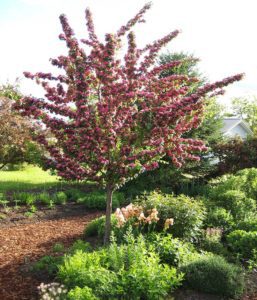April 16 Column: Trees

Have you ever taken a moment to admire trees and appreciate all they do for the environment around it? They are pretty amazing. They just happen to be the topic of my column in today’s edition of The Spokesman-Review. Here’s a link to it: Trees give us so much, including beauty, clean air, sustenance. (or you can read my column lower in this post)
It seemed like an important topic to cover, what with Arbor Day being on April 28th.
And now it’s time for my next “Everyone Can Grow A Garden!” video. It would’ve been nice to do a tree-oriented video. However, it’s important to continue with information on growing your own garden. Have a look:
And last but not least — just because I know at least one of you are going to ask! The photo within this post is a ‘Paul’s Scarlet’ hawthorn in our backyard. And the blossoms at the top of this post are from an unnamed crabapple variety.
Trees garden column:
by Susan Mulvihill
Have you ever stopped to think about the trees planted in our parks, along city streets and in our backyards? They are an important aspect of the environment around us. Unfortunately, they frequently are relegated to the background as we look past them to other things.
They will be in the spotlight on April 28, which is National Arbor Day. The Arbor Day Foundation says this special day “celebrates the role of trees in our lives and promotes tree planting and care.”
Special trees for our landscapes
There are so many different types around us. Some treat us to beautiful flowers in the spring. Others wait until fall to wow us with their amazing fall foliage. Many are desirable for their interesting structure or growth habit, or perhaps their tantalizing seed pods or pinecones. No matter which attributes appeal to you, trees are quietly benefitting us in so many ways.
How do they benefit us?
Think about the hot days of summer when we seek out shady spots in our gardens. Both evergreen and deciduous trees give us comfort and protection from the hot sun. When our homes are shaded, they are cooler as well. And that cuts down on the need for fans or air conditioning.
Trees remove carbon dioxide from the air — storing it in their leaves, branches and roots — and produce oxygen through photosynthesis. They filter pollutants from the air as well.
The roots help prevent soil erosion. They also filter storm water to keep oils and chemicals from entering our aquifer and nearby rivers and streams. In the fall, the leaves of deciduous trees provide us with free materials for mulching and composting in our gardens.
They benefit our birds, too
Birds are very dependent on trees for nesting, places to roost or hide from predators, and for food. Our waxwings and robins are thankful for the fruits and berries on our crabapple and hawthorn trees each winter and spring. Just the presence of trees will attract birds to the landscape.
I am very appreciative of the bounty from our apple, cherry and plum trees every year. And I enjoy sharing the abundance with local food pantries.
Think about how trees add value
Established trees add to the value of our homes as well. Have you ever gone to a tree nursery and been interested in purchasing a large-caliper tree? Then you know firsthand just how much those trees can cost.
Trees can be used to screen unsightly views and to muffle the sounds on busy streets. When closely planted, they also are used to block the wind.
What’s more, trees add a calming, peaceful sense to the landscape. So the next time you’re outside, take a moment to consider all the things trees do for us. Take good care of your trees. And look for opportunities to add more of them to your yard, neighborhood and community.

